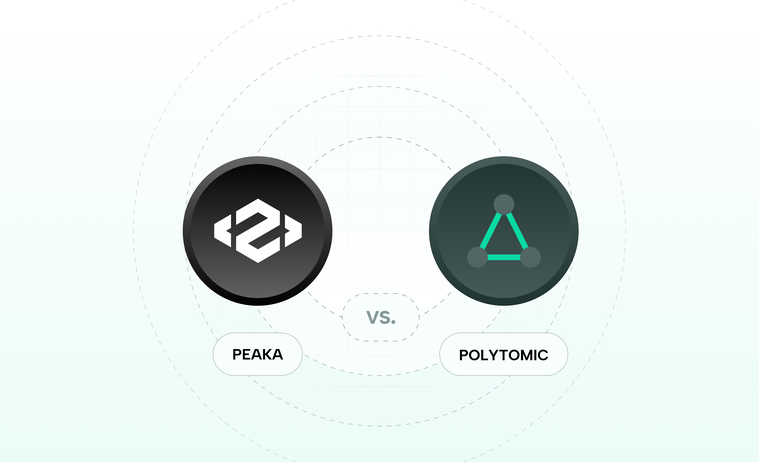Polytomic vs Peaka: Which is Best for Embedded Analytics?
SaaS companies are no longer just syncing data. They’re turning data into products by monetizing it through in-product analytics. That means embedding real-time dashboards, campaign analytics, and even AI copilots directly inside their apps. To do this well, you need more than ETL pipelines or unified APIs. You need a full embedded data stack.
Polytomic and Embedded Peaka both promise to simplify data access. But while Polytomic helps internal teams sync operational data into tools like Salesforce or Postgres, Peaka is purpose-built to help SaaS teams embed customer-facing analytics experiences into their product UI.
Here’s how the two platforms compare and why Peaka has the edge over Polytomic:
1. Polytomic moves data, Peaka embeds it
Polytomic focuses on syncing data from warehouses or databases into internal business tools such as Salesforce, HubSpot, or Airtable. It’s great for making internal teams more data-driven and feeding the data into the existing stack.
Embedded Peaka, on the other hand, is built to replace that stack. It functions as a data delivery layer that connects to any data source, unifies the data, and serves it to customers using a platform.
| Feature | Embedded Peaka | Polytomic |
|---|---|---|
| Deployment Mode | ✅ Purpose-built for embedding | 🟡 Early-stage embedded |
| UI Components | ✅ Dialogs, query editor, autocomplete | ❌ No SDK/UI |
| Branding & Theming | ✅ Full white-labeling | ❌ None |
What this means for you
If your goal is to let users see their Stripe, GA4, or Zendesk data in your SaaS UI instead of their CRM, Polytomic simply isn’t built for that.
2. Peaka eliminates data replication and data warehouses
Polytomic does not come with a federated query capability, a query engine, or smart caching. It uses data replication to integrate data. Therefore, you still need to have a storage layer, build and maintain ETL pipelines, and develop UI components.
With Embedded Peaka, you don’t have to maintain a data warehouse or replicate data into your internal systems. Embedded Peaka leverages federated queries to query data at the source and uses smart caching to offer the optimum blend of speed and cost per query.
| Feature | Embedded Peaka | Polytomic |
|---|---|---|
| Data Access Model | ✅ Live querying (no replication) | ❌ Requires pushing to DB |
| Query Engine | ✅ Built-in (Trino-based) | 🟡 Some query support (unclear depth) |
| Caching & Rate Limit Handling | ✅ Rate limit-aware caching built-in | ❌ No caching built-in |
What this means for you
Peaka gives you query-ready data that you can embed inside your product right away. Polytomic gives you the pipelines you need to operate and maintain.
3. Peaka reduces engineering overhead
Whether it is handling OAuth keys and credentials, introducing multitenancy, or maintaining connectors, you’re on your own when you’re using Polytomic.
Embedded Peaka offers all of this and more:
-
Hosted or BYO OAuth with full tenant awareness
-
Project-, catalog-, and schema-level isolation
-
Role-, column-, and row-level permissions
-
Audit logs and data lineage
| Feature | Embedded Peaka | Polytomic |
|---|---|---|
| OAuth | ✅ Hosted, tenant-aware | 🟡 To be handled by the user |
| Multitenant Support | ✅ Native project/catalog isolation | ❌ None |
| Connector Maintenance | ✅ Peaka-managed | 🟡 To be maintained by the user |
What this means for you
Peaka reduces frontend, infra, and compliance work so you ship embedded analytics in weeks, not quarters.
4. Peaka offers a complete solution, not a data pipeline
SaaS teams planning to use Polytomic for embedding analytics into their products should be prepared for increased workloads. Polytomic does not provide essential features such as UI components, multitenancy, or branding that are crucial for embedded analytics, leaving SaaS teams to develop them in-house.
Embedded Peaka, on the other hand, was built to simplify life for these SaaS teams. Its AI-enhanced query editor, ready-made connector dialogs, autocomplete, and visual theming support help product teams save weeks that would otherwise be spent reinventing the wheel.
What this means for you
Embedded Peaaka helps SaaS companies free up their engineering resources to develop and refine business-critical capabilities instead of spending time on boilerplate items.
Key takeaways
-
Polytomic is built for internal data sync, helping teams push data into tools like Salesforce, but not for embedding customer-facing analytics.
-
Embedded Peaka offers a complete embedded data platform, with live querying, smart caching, UI components, and multitenant governance.
-
Embedded Peaka eliminates the need for a data warehouse, whereas Polytomic requires syncing data into your own database before it can be utilized.
-
SaaS teams can ship dashboards faster with Embedded Peaka, avoiding the need to build OAuth flows, query infrastructure, or frontend UIs from scratch.
Final word: Polytomic pulls in data, Peaka turns data into a product
Hevo is an excellent choice for centralizing data into a warehouse for internal analytics.
But if your goal is to embed real-time data, analytics, or AI insights directly into your product without building all the infra yourself, Embedded Peaka is purpose-built for you.
Don’t build a stack to deliver analytics. Embed one with Peaka.
Explore Embedded Peaka or book a demo to learn how to deliver customer-facing dashboards in days, not quarters.
Each platform offers something different, but if you’re looking for the fastest path to in-product analytics, you’ll want to see how Embedded Peaka measures up across the board:




 Please
fill out this field
Please
fill out this field













